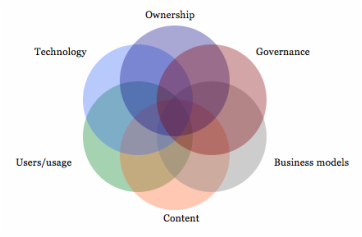Disassembling Platforms, Reassembling Sociality
Chapter Two used actor-network theory (ANT) and political economy as a means to study the complex dynamics of media. ANT centers on "coevolving networks of people and technologies," while political economy centers on "the economic infrastructure and legal-political governance" (van Dijck, 2013, p. 26). José van Dijck conceded that both may not be ideal bedfellows for her topic, but she felt they were important to explain social platforms and sociality in relation to the rising culture of connectivity. I believe using ANT and political economy complicates her critique more than aids in its structured analysis, and the average audience outside this topic just beginning to look in may become confused given her complicated organization. Here, ANT works well as a constructivist approach that explains theory by examining the combinations and interactions that make the theory effective. The combinations and interactions are connections that are essential to her analysis and to its successful understanding by the audience.
The six elements van Dijck discussed serve as the fulcrum of her analysis concerning past and present social media and as can be seen in the Venn diagram below, they overlap.

Disassembling platforms as microsystems. Source: van Dijck, p. 28 (2013).
Platforms as Techno-cultural Constructs
- Technology: can be used to steer user behavior (Amazon coding preferences, LinkedIn coding connections).
- Users and usage: changes in platforms (social networking sites, or SNSs) can force users to change settings or quit the site—those users who like such changes tend to stay and build connections.
- Content: design and distribution of content is essential for users to communicate through an effective use of the platform.
Platforms as Socioeconomic Structures
- Ownership: even though site ownership may change over the years, SNSs still tell users what they like, want, know, and should be looking for.
- Governance: early on, users patrolled their own sites, now "terms of service" and algorithms protect users from users, content from users, and users from content.
- Business models: strategies for monetizing spaces can impact usability and content (inserting advertising into Twitter streams and Facebook news feeds).
Essentially, these elements served as the basis for her critical analysis of social media and the subsequent platforms that have helped to build it over the years. Each chapter of the book was broken down into these six sections and used to analyze a specific social network. This structure worked well to reveal a consistent theme concerning the development of each SNS, and while it was not entirely unique, its consistency was an excellent means of organization.